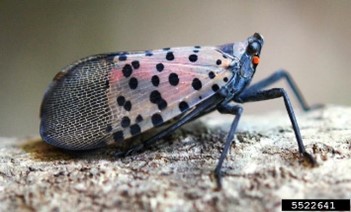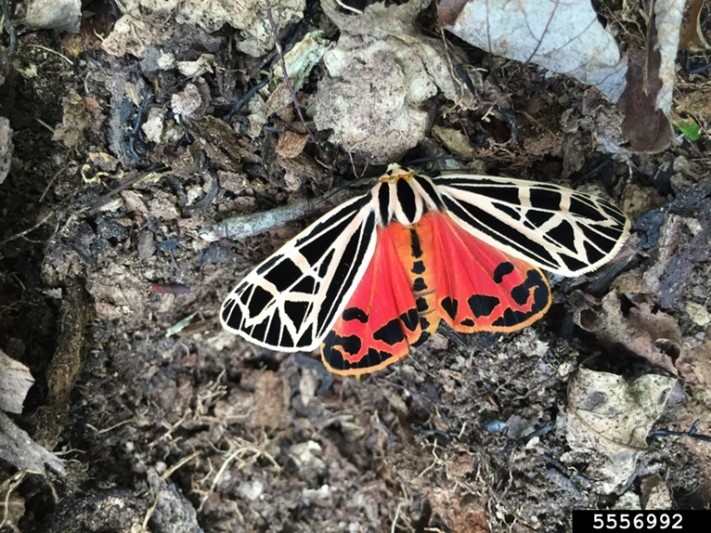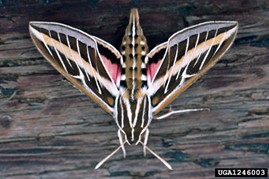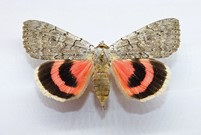
Spotted lanternfly (SLF)

Spotted lanternfly (SLF) is an invasive insect from China that feeds on the sap of a wide variety of plants, including forest trees, such as black walnut, maple, birch, and willow, as well as important agricultural crops, such as grape, hops, apple, and cherry. To feed, this insect inserts its straw-like mouthpart through the plant’s bark, which creates wounds allowing plant diseases a point of entry. This feeding causes adults and immatures to produce large amounts of a sugary substance called honeydew which coats surfaces below them. Black sooty mold can grow on the honeydew, potentially affecting the plant’s appearance and health. Large numbers of SLF feeding can lead to plant stress, reduced health, and in some cases death.
Biology
Spotted lanternfly (SLF) eggs hatch in spring. The immature insects are black with white spots. After feeding all summer, they turn bright red with white and black markings. As adults, they are about an inch long and a half inch wide. Their forewings are grayish-brown with black spots; the hindwings are bright red with black spots and white and black bars. Adults and young feed on more than 70 species of trees, shrubs and vines, including grapevines, hops, fruit trees, maple trees, black walnut, and other hardwoods. Adults prefer Tree of Heaven (also an invasive species). This is a sap-sucking insect that feeds on plant sap by sucking it through their straw-like mouth parts. For more information visit the USDA APHIS spotted lanternfly website.
Where it’s from
SLF is native to China and other parts of southeast Asia. It was first detected in 2014 in Berks County, Pennsylvania. As of December 2021, infestations haves been confirmed in 11 other U.S. states.
How it spreads
Adult SLF can lay egg masses on almost any surface, including vehicles, trailers and trees, which means accidental human movement is a problem. Adults can also fly short distances. It is important to thoroughly examine vehicles and outdoor materials for egg masses when leaving an area where SLF has been reported.
Where it’s found
As of December 2021, SLF populations are in 11 states including: Connecticut, Delaware, Indiana, Maryland, Massachusetts, New Jersey, New York, Ohio, Pennsylvania, Virginia, and West Virginia.
What’s being done
Several states in the eastern United States have enacted quarantines in counties with heavy SLF infestations, regulating the movement of materials or objects that can spread SLF. Other states without severe infestations, have restricted the movement of materials and objects coming from quarantined areas. Local, state and federal government are partnering to implement control or eradication programs in areas with, or near, known SLF infestations. Visual inspection or trapping methods can find new SLF infestations, which can be controlled by scraping egg masses off surfaces into an alcohol solution to kill them.
Control methods include removing or treating tree of heaven with insecticide within a quarter mile of an SLF detection, then chipping or grinding debris before burning. The USDA and several state universities and research institutions are studying SLF biology and behavior to develop more control methods.
Images of SLF and its damage
Early/young infestations or pests:



Older SLF:


Early damage:

Later damage:

Look alikes:






Is Spotted Lanternfly near me?
Check the USDA APHIS – "Where's the Threat and How to Report It" webpage
What can be done?
Homeowners:
There are several management tactics individuals can use to manage SLF populations:
Homeowners can inspect their property for SLF egg masses and scrape them into a container with rubbing alcohol or hand sanitizer then dispose of the entire container.
Traps can also be set on trees with heavy infestations to target the immature insects that walk up the tree trunk after hatching. Effective traps are either a sticky band that wraps around the circumference of the trunk or a funnel-style trap that consists of mesh wrapped around the tree leading to a container. Traps should be checked and changed every other week, or more in highly infested areas.
Tree of Heaven, an invasive tree that is highly preferred by SLF, can be removed from private property.
Chemical control may also be used by homeowners. Tree injections are usually applied by professional applicators. Soil drenches, which are poured on the soil around the tree trunk, bark sprays, which are applied to the bark of the lower tree trunk, and direct sprays, which are applied directly to SLF and surfaces they walk and feed on, can all be applied by homeowners.
To stop the spread of SLF, thoroughly check vehicles and any outdoor materials and objects that are being moved for SLF egg masses when travelling from areas with established SLF infestations. SLF may also find its way into vehicles if windows are left open. Firewood should never be moved. More information from Penn State University here.
Businesses:
USDA APHIS – "Businesses Can Help Stop Spotted Lanternfly" webpage.
Regulatory information
USDA APHIS – "Pest Tracker" webpage gives information on quarantines for various pests in U.S. states
Who to contact
-
Reporting SLF —
- MSU Plant & Pest Diagnostics: Email pestid@msu. edu or call 517-432-0988. https://www.canr.msu.edu/ipm/invasive_species/spotted-lanternfly
- Midwest Invasive Species Information Network’s (MISIN): use the online reporting tool or download the MISIN smartphone app and report from your phone: http://www.misin.msu.edu/ tools/apps/#home http://www.misin.msu.edu/facts/detail/?project=misin&id=321&cname=Spotted%20lanternfly
- USDA APHIS – ”Where’s the Threat and How to Report It” webpage